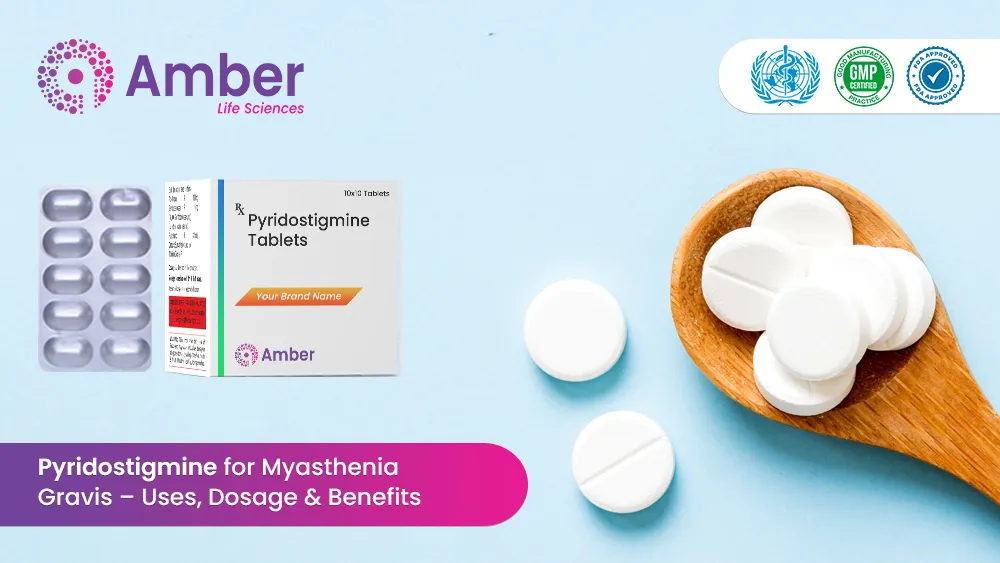Pyridostigmine is a cholinesterase inhibitor used primarily to treat myasthenia gravis, a chronic autoimmune neuromuscular disorder that causes muscle weakness. It works by improving communication between nerves and muscles, thereby enhancing muscle strength and endurance. Pyridostigmine is also used in the military as a preventive measure against nerve agent poisoning.
Important Features of Pyridostigmine
1. Mechanism of Action:
- Pyridostigmine inhibits the enzyme acetylcholinesterase, which breaks down acetylcholine (a neurotransmitter responsible for muscle contraction).
- By preventing the breakdown of acetylcholine, pyridostigmine increases its availability at the neuromuscular junction, improving muscle strength and function.
2. Uses of Pyridostigmine:
- Myasthenia Gravis: Pyridostigmine is primarily used to manage muscle weakness in this condition.
- Nerve Agent Poisoning: Used as a pretreatment for exposure to organophosphate nerve agents (e.g., sarin, soman) in military settings. It temporarily binds to acetylcholinesterase, protecting it from irreversible inhibition by nerve agents.
Dosage of Pyridostigmine:
Myasthenia Gravis:
- Typical starting dose: 30–60 mg orally every 3–6 hours, adjusted based on response and tolerance.
- Daily dose should not exceed 1,200 mg.
- A sustained-release form (180 mg) is available to manage symptoms overnight.
Nerve Agent Pretreatment:
- Typical dose: 30 mg every 8 hours, starting before potential exposure and continuing during the period of risk.
Advantages of Pyridostigmine:
1. Improves Muscle Strength: Effectively reduces muscle weakness and fatigue in myasthenia gravis.
2. Flexible Dosing: Available in immediate-release and sustained-release forms for tailored symptom management.
3. Nerve Agent Protection: Provides a protective effect against nerve agent poisoning in military or high-risk settings.
Side Effects of Pyridostigmine:
Pyridostigmine is generally well-tolerated, but side effects may occur due to excessive acetylcholine activity.
1. Common Side Effects:
- Nausea, vomiting, or diarrhea.
- Abdominal cramps or increased salivation.
- Excessive sweating or tearing.
2. Less Common Side Effects:
- Muscle twitching or cramps.
- Blurred vision or miosis (pupil constriction).
- Bradycardia (slow heart rate).
3. Serious Side Effects (Rare):
- Cholinergic Crisis: Overdose can cause severe muscle weakness, respiratory distress, and excessive secretions. This is a medical emergency.
Contraindications:
- Hypersensitivity to pyridostigmine or other cholinesterase inhibitors.
- Mechanical bowel or urinary obstruction: Pyridostigmine can increase smooth muscle activity, worsening these conditions.
- Severe asthma or COPD: May exacerbate bronchospasm.
Drug Interactions:
- Other cholinesterase inhibitors: Increased risk of cholinergic side effects.
- Beta-blockers: May exacerbate bradycardia.
- Succinylcholine: Pyridostigmine may prolong its effects.
- Atropine: Used to treat cholinergic side effects but may mask overdose symptoms.
Precautions:
1. Dosing Adjustments: Begin with a low dose and increase gradually to reduce side effects.
2. Monitoring: Regularly monitor muscle strength and side effects, especially in patients with myasthenia gravis.
3. Cholinergic Crisis: Recognize signs of overdose, such as severe muscle weakness or respiratory distress, and seek immediate medical attention.
4. Pregnancy and Breastfeeding: Use only if needed and under medical supervision.
Effectiveness:
Pyridostigmine effectively alleviates myasthenia gravis symptoms, enhancing muscle strength and quality of life. It is a cornerstone of myasthenia gravis treatment and is often used in combination with other therapies (e.g., immunosuppressants).
Comparison with Other Cholinesterase Inhibitors:
| Feature | Pyridostigmine | Neostigmine | Edrophonium |
|---|---|---|---|
| Primary Use | Myasthenia gravis, nerve agent pretreatment | Myasthenia gravis, postoperative ileus | Diagnostic for myasthenia gravis |
| Duration of Action | 3–6 hours | 2–4 hours | 5–10 minutes |
| Route of Administration | Oral, IV | Oral, IV, IM | IV |
| Side Effects | Cholinergic side effects | Cholinergic side effects | Cholinergic side effects |
Conclusion:
Pyridostigmine is a vital medication for managing myasthenia gravis and provides protective benefits against nerve agent poisoning. It is generally well-tolerated but requires careful dosing and monitoring to avoid side effects. Always consult your healthcare provider before starting or adjusting pyridostigmine therapy.









